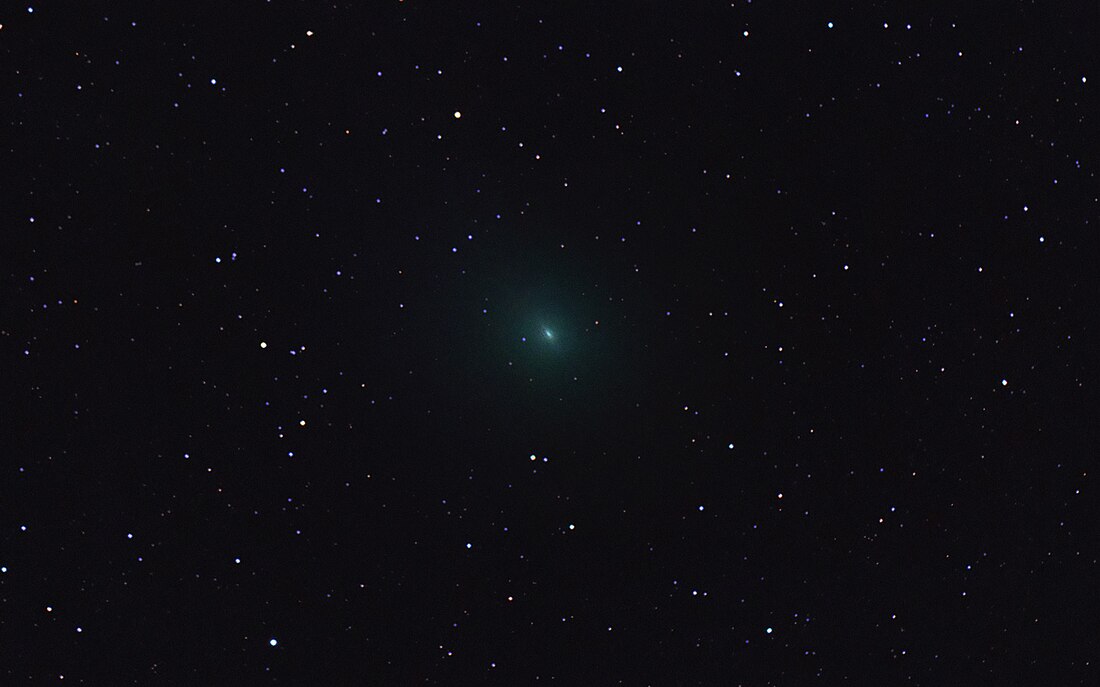Top Qs
Timeline
Chat
Perspective
45P/Honda–Mrkos–Pajdušáková
Periodic comet with 5 year orbit From Wikipedia, the free encyclopedia
Remove ads
45P/Honda–Mrkos–Pajdušáková is a short-period comet discovered by Minoru Honda December 3, 1948.[9] It is named after Minoru Honda, Antonín Mrkos, and Ľudmila Pajdušáková. The object revolves around the Sun on an elliptical orbit with a period of 5.25 years.[3] The nucleus is 1.3 kilometers in diameter.[7] On August 19 and 20, 2011, it became the fifteenth comet detected by ground radar telescope.[10]
During the 1995 perihelion passage, the comet was visible to Solar and Heliospheric Observatory (SOHO) on January 16, 1996, when the comet was around apparent magnitude 7 and 4.3° from the Sun.[9]
It is green because it emits diatomic carbon which glows green in the near vacuum of space.[11]
Remove ads
2011 passage
During the 2011 perihelion passage, the comet was recovered on 5 June at magnitude 21.[12] On 8 July, the comet had a magnitude of approximately 18,[13] and, as of 22 July, nuclear condensation was noticed around magnitude 16.[14] It was expected to reach a peak magnitude of around 7.3 in late September near perihelion.[15]
On August 15, 2011, the comet made a close approach of only 0.0600 AU (8,980,000 km; 5,580,000 mi) from the Earth[16][17][18] and it was studied by the Goldstone Deep Space Network.[19] Radar observations on August 19 and 20 detected echoes from the nucleus and coma.[10]
Remove ads
2017 passage
45P/Honda–Mrkos–Pajdušáková came to perihelion on December 31, 2016.[3] By February 4, 2017, it was around magnitude 7 and the coma was about 100,000 km across.[20] The comet required binoculars to be seen because of the low surface brightness.[21] The comet passed 0.08318 AU (12,444,000 km; 7,732,000 mi) from Earth on February 11, 2017, which was the same day as a lunar eclipse.[17][22]


 |
| This shows the path of the comet during January through March 2017, with daily motion drawn as spheres, scaled for relative distance from earth. |
The next notable close approach will be in October 2032[17] when the comet might brighten to magnitude 7.
Remove ads
August Delta Capricornids
On 16 August 2022 the global CAMS and Sonotaco network detected a modest outburst of meteors with an orbit that resembled comet 45P.[23] The shower received the temporary designation of M2022-Q1, and was later permanently named the August Delta Capricornids.[24] The meteors had an entry speed of 24.4 km/s and originated from the border of Aquarius and Capricornus with R.A. 21:40 and a declination of –11.9°.[23] This was the first time an encounter with a dust trail of 45P has been confirmed and it came from the 1980 meteoroid stream of 45P.[24] In all, 137 meteors were triangulated by the global CAMS networks.
References
External links
Wikiwand - on
Seamless Wikipedia browsing. On steroids.
Remove ads

